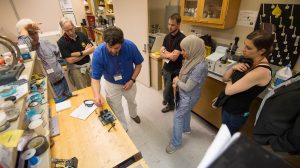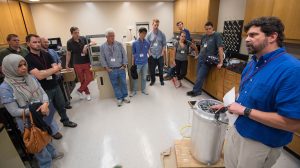
Josh Gladden, interim vice chancellor for research and sponsored programs at the University of Mississippi, leads a demonstration at the National Center for Physical Acoustics during the 2018 Physical Acoustics Summer School. Photo by Kevin Bain/University Communications
OXFORD, Miss. – Sometimes the quickest introduction to cutting-edge physical acoustics is questioning why a whistling bottle rocket whistles.
That’s why Greg Swift, a member of the Condensed Matter and Magnet Science Group at Los Alamos National Laboratory in New Mexico, held a bottle rocket – unlit – in a ballroom at The Inn at Ole Miss earlier this month (June 3-8) during the 2018 Physical Acoustics Summer School, or PASS.
The summer school included 43 physical acoustics students and lecturers from around the country as well as the United Kingdom and China, who gathered on the University of Mississippi campus to discuss various physical acoustics subjects, from thermoacoustics to active noise control. During the week, graduate students got the chance to meet with experts and discuss physical acoustics topics they rarely encounter at their own colleges and universities.
“PASS is an intensive week where graduate students from around the world get exposed to a wide variety of fundamental topics in physical acoustics taught by world-class experts,” said Josh Gladden, UM interim vice chancellor for research and sponsored programs.
“In addition to the broad technical knowledge, [the school] provides a wonderful opportunity for the graduate students to form relationships with their peers and professionals in the field. As a PASS 2000 graduate, I still keep in touch with my classmates.”
While Swift’s presentation on thermoacoustics kicked off the week of physical acoustics subject matter, the school also included six more presentations, covering topics such as the acoustics of bubbles and bubbly fluids, biomedical ultrasound and active noise control.
Later during his demonstration, Swift pulled out a blowtorch and heated a glass tube, recreating the “singing tube,” an invention by Charles T. Knipp. A longtime University of Illinois physics professor who died in 1948, Knipp was well-known for his experiments in rainmaking and the conduction of electricity through glass.
The tubes are useful in demonstrations to showcase the conversion of heat energy into sound through a vibrating air column.
Throughout his demonstration, even while going over complex acoustical physics problems such as Fourier’s law of heat conduction, Swift kept the students – from 16 U.S. and two international universities – and lecturers enthralled.

Josh Gladden, interim vice chancellor for research and sponsored programs at the University of Mississippi, leads a tour of the National Center for Physical Acoustics during the 2018 Physical Acoustics Summer School. Photo by Kevin Bain/University Communications
Early on, he told the group members that he expected them to participate and peppered his presentation with questions such as “Why do some of these bottle rockets whistle?” “What’s the meaning of the question: Why does it whistle?” “What’s the scientific approach to a puzzle like this?” “What is still missing from our explanation here?”
Swift even showed a cutaway of a whistling bottle rocket that he cut out himself, which was why the cuts were so jagged, he joked.
Students gradually worked through an explanation of why a whistling bottle rocket whistles that involves the bottle rocket’s pyrotechnic composition, shape and combustion dynamics.
During a session on active noise control, Scott Sommerfeldt, a professor in the Brigham Young University Department of Physics and Astronomy, posed more questions to the students.
“Where did the energy go?” he asked. “Are we violating physics here?”
Sommerfeldt is researching methods for reducing unwanted sounds by matching sound against sound to create silence. The research has practical applications from quieting noisy propeller-driven aircraft to hushing air-conditioning systems and office equipment. His talk ranged from an introduction to inventor Paul Lueg, a German generally credited with beginning active noise control in the 1930s, to modern research into noise-cancellation methods.
One afternoon, the students and lecturers toured the National Center for Physical Acoustics, which serves as the Physical Acoustics Archives for the Acoustical Society of America and coordinates the biennial school.
The group toured labs and learned more about the center’s research in areas such as aeroacoustics and porous media, including the study of how to use acoustic waves to detect buried objects and structures such unexploded ordnance, improvised explosive devises, and tunnels, and how to use acoustics to measure the sediment payload carried by rivers and streams.
The 2018 edition of the Physical Acoustics Summer School received high marks from attendees, said Gladden, who recently was elected as a fellow of the Acoustical Society of America for his service to and leadership in the field of physical acoustics.
“Having PASS on the Ole Miss campus gives us the chance to show off our physical acoustics facilities right here in Oxford,” he said. “Students got to see cutting-edge acoustics research and ask senior scientists detailed questions.”
This year’s school was supported by the Acoustical Society of America, National Center for Physical Acoustics at UM and Applied Research Laboratories at the University of Texas.